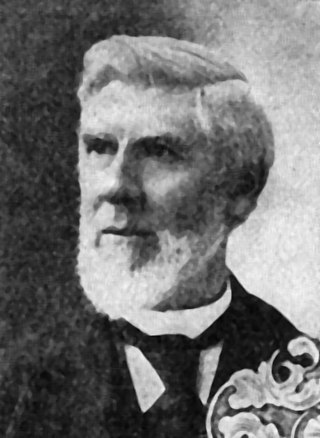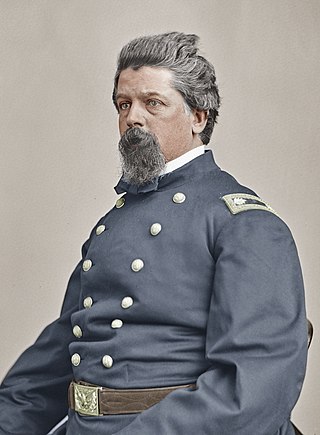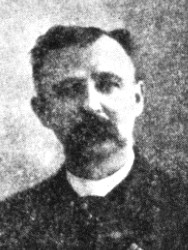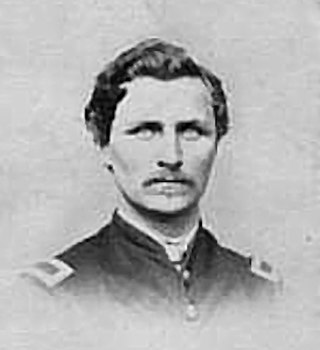
Henry M. Fox was a Union soldier during the American Civil War, and a Medal of Honor recipient.

Chester Bennett Bowen was a Union soldier during the American Civil War. He received the Medal of Honor for gallantry during the Battle of Opequon more commonly called the Third Battle of Winchester, Virginia on September 19, 1864. Corporal Bowen was one of two members of the 1st New York Dragoons to receive the Medal of Honor for this action. The other was Sgt. Andrew J. Lorish.

Gabriel Cole was a Union Army soldier during the American Civil War. He received the Medal of Honor for gallantry and the capture of the flag of the 45th Virginia Infantry Regiment during the Battle of Opequon more commonly called the Third Battle of Winchester, Virginia on September 19, 1864.

Henry W. Downs was a Union Army soldier serving in the 8th Vermont Volunteer Infantry Regiment during the American Civil War. He received the Medal of Honor for gallantry during the Battle of Opequon more commonly called the Third Battle of Winchester, Virginia on September 19, 1864.CITEREFSightline_Media_Group,Henry_W._Downs_(2020) He is buried at Dayton National Cemetery in Dayton, Ohio.

Patrick H. McEnroe was a Union Army soldier during the American Civil War. He received the Medal of Honor for gallantry during the Battle of Opequon more commonly called the Third Battle of Winchester, Virginia on September 19, 1864.

George E. Meach was a Union Army soldier during the American Civil War. He received the Medal of Honor for gallantry during the Battle of Opequon more commonly called the Third Battle of Winchester, Virginia on September 19, 1864.

Peter J. Ryan was a Union Army soldier during the American Civil War. He received the Medal of Honor for gallantry during the Battle of Opequon more commonly called the Third Battle of Winchester, Virginia on September 19, 1864.

Charles H. Seston was a Union Army soldier killed in action during the American Civil War. He posthumously received the Medal of Honor for gallantry during the Battle of Opequon more commonly called the Third Battle of Winchester, Virginia on September 19, 1864.

John T. Sterling was a Union Army soldier during the American Civil War. He received the Medal of Honor for gallantry during the Battle of Opequon more commonly called the Third Battle of Winchester, Virginia on September 19, 1864.

James Connors was an Irish born Union Army soldier during the American Civil War. He received the Medal of Honor for gallantry during the Battle of Fisher's Hill near Strasburg, Virginia fought 21–22 September 1864. The battle was one of the engagements of the Valley Campaigns of 1864.

George G. Moore was a Union Army soldier during the American Civil War. He received the Medal of Honor for gallantry during the Battle of Fisher's Hill near Strasburg, Virginia fought September 21–22, 1864. The battle was one of the engagements of the Valley Campaigns of 1864.

Eri Davidson Woodbury was a Union Army officer during the American Civil War. He received the Medal of Honor for gallantry during the Battle of Cedar Creek fought near Middletown, Virginia on October 19, 1864. The battle was the decisive engagement of Major General Philip Sheridan’s Valley Campaigns of 1864 and was the largest battle fought in the Shenandoah Valley.

Henry H. Crocker was a Union Army officer during the American Civil War. He received the Medal of Honor for gallantry during the Battle of Cedar Creek fought near Middletown, Virginia on October 19, 1864. The battle was the decisive engagement of Major General Philip Sheridan's Valley Campaigns of 1864 and was the largest battle fought in the Shenandoah Valley.

David H. Scofield was a Union Army soldier during the American Civil War. He received the Medal of Honor for gallantry during the Battle of Cedar Creek fought near Middletown, Virginia on October 19, 1864. The battle was the decisive engagement of Major General Philip Sheridan’s Valley Campaigns of 1864 and was the largest battle fought in the Shenandoah Valley.

Thomas McCoy Wells was an Irish born Union Army soldier and officer during the American Civil War. He received the Medal of Honor for gallantry during the Battle of Cedar Creek fought near Middletown, Virginia on October 19, 1864. The battle was the decisive engagement of Major General Philip Sheridan's Valley Campaigns of 1864 and was the largest battle fought in the Shenandoah Valley.

Richard Taylor was a Union Army soldier during the American Civil War. He received the Medal of Honor for gallantry during the Battle of Cedar Creek fought near Middletown, Virginia on October 19, 1864. The battle was the decisive engagement of Major General Philip Sheridan's Valley Campaigns of 1864 and was the largest battle fought in the Shenandoah Valley.

Martin Wambsgan was a German born Union Army soldier during the American Civil War. He received the Medal of Honor for gallantry during the Battle of Cedar Creek fought near Middletown, Virginia on October 19, 1864. The battle was the decisive engagement of Major General Philip Sheridan's Valley Campaigns of 1864 and was the largest battle fought in the Shenandoah Valley.

Edwin Goodrich was a Union Army officer during the American Civil War.

Orlando Phidelio Boss (1844-1931) was a corporal in Company F, 25th Massachusetts Volunteer Infantry during the American Civil War. He received Medal of Honor for his bravery at the Battle of Cold Harbor, Virginia on June 3, 1864. Prior to rescuing Lieutenant Daly of his regiment, he had dragged another wounded comrade to safety among the enemy fire. He had then appealed to his brigade commander, General George J. Stannard, for permission to rescue the lieutenant. General Stannard consented, and Boss succeeded in bringing the wounded office despite a torrent of enemy gunfire that erupted at him during his deed.

William Wirt Winegar was a Union Army officer during the American Civil War. He received the Medal of Honor for gallantry during the Battle of Five Forks fought on April 1, 1865 southwest of Petersburg, Virginia. The battle was part of the Appomattox Campaign and was a victory for Union forces under Maj. Gen. Philip H. Sheridan over Confederate Maj. Gen. George E. Pickett.







